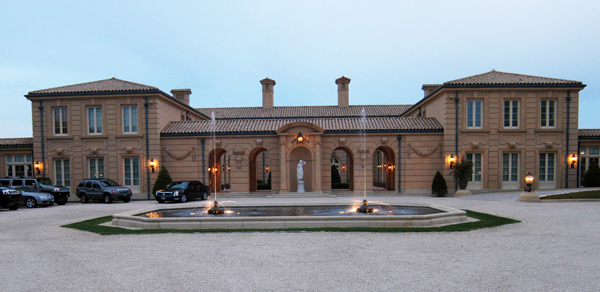For about a year, Michael Bloomberg, the billionaire former New York City mayor and a Hamptons habitué, has been trying to reroute a road that runs straight through Southampton’s tony Shinnecock Hills Golf Club, of which he is a member.
Last summer, Brett Pickett, the club’s president, along with Bloomberg, proposed funding Tuckahoe Road’s rerouting to the tune of about $5 million. The proposal was put on hold in November, but Bloomberg reportedly contacted Town Highway Superintendent Alex Gregor this spring about reviving the plan.
Some local residents were up in arms about the proposal, of course. They like the scenic road the way it is and don’t want their elite neighbors changing things to suit their whims.
“People felt the billionaires were coming in,” said Jay Schneiderman, Southampton Town Supervisor. “There were a lot of class issues.”
Bloomberg, who did not respond to requests for comment, is hardly the only prominent figure to become involved in a Hamptons planning controversy. It’s not an infrequent occurrence for a rich-and-famous Hamptons resident to be involved in local real estate controversies — rezoning and development plans often aimed at pushing a pet project or just constructing a fabulous addition to their home that the rest of the neighborhood finds unappealing. Some might even call it a right of passage for a certain echelon of Hamptonite.
Despite their outsize money and fame, celebrities don’t always win these battles.

Michael Bloomberg
“The town will fight hard where it thinks the right of its citizens are in jeopardy, regardless of who is on the other side,” says Daniel Rattiner, founder and longtime editor of Dan’s Papers.
Here’s a look at some noteworthy real estate controversies, past and present, involving celebrities or just the plain filthy rich.
Bloomberg and Tuckahoe Road
The ruckus at Shinnecock is one of the most high-profile current cases of a billionaire throwing his weight around. Tuckahoe Road intersects Montauk Highway, then traverses the golf club. If the rerouting were to happen, the road would no longer go through the course, and that section would be used only by club members or closed.
According to Schneiderman, Shinnecock has cited safety concerns because of the number of vehicles on the road, which drivers take to avoid traffic on the highway. Cars and trucks often drive very fast in the recreational area, a risk to golfers. A spokesman for Shinnecock Golf Club declined to comment. The opposition, on the other hand, asserts that the new road would cause drainage problems and pose a hazard to pedestrians and bicyclists.
For now, there’s not much of a chance the matter will be taken up again soon, despite the fact that the 2018 U.S. Open will be returning to the club. Southampton Hospital is planning to move to the Stony Brook Southampton campus, south of the golf course. That relocation is likely to have a significant impact on traffic patterns, and eventually may require changes to the road anyway for ambulance access. “There’s no point in discussing anything until we know about the placement of the new hospital, and that’s years away,” says Schneiderman.
Alec Baldwin vs. Ed Norton: The Hills in East Quogue
For more than a year, actor and Donald Trump impersonator Alec Baldwin, an Amagansett resident, has teamed up with residents opposing construction of an 18-hole golf course, clubhouse and 118-luxury-home resort on 600 acres in East Quogue dubbed the Hills. Saying he was concerned about the environmental impact, Baldwin described the project as “the biggest and baddest development on Long Island” in a public service announcement last year.
Enter actor Ed Norton — friend of the Hills’ developer Mike Meldman of Discovery Land Co. — who joined the fight, advising his real estate pal on how to prevent water pollution. For his part, Norton boasts (relatively speaking) considerable environmental bona fides as president of the U.S. board of the Maasai Wilderness Conservation Trust and a U.N. goodwill ambassador for biodiversity.
Those against the development cite concerns that developers have too much wiggle room thanks to planned development districts (PDDs), which give developers more flexibility in land use. Schneiderman expects a final decision by late summer or early fall.

Madonna
Madonna’s farm
In 2013, the singer bought a 26-acre parcel of land adjacent to her $4.9 million Bridgehampton horse farm to use as a tree nursery. Back in 2010, the Town of Southampton and Suffolk County had purchased development rights for the property for $10 million, to ensure the land was preserved. Because the land wasn’t developable, Madonna was able to pay a reported $2.2 million for the parcel, but she had to use it for commercial agricultural purposes. Under New York State’s Agriculture and Markets law, however, she could use the property as a vineyard or nursery. Enter the tree farm, for which she also received a tax break. Although the locals grumbled that the Material Girl only wanted the land as a way of securing her privacy, she ended up having it her way.
Mariska Hargitay: Nixing a tree house
In January, the East Hampton Village Zoning Board of Appeals nixed the “Law & Order: Special Victims Unit” star’s request for a variance for a tree house, swing set and basketball hoop already built on the property of her East Hampton house. The reason: It was too close to the property line. The remedy: She was ordered to remove it from that line. It’s all despite the fact that Bad Company drummer Simon Kirke reportedly built it when he previously owned the house.
Howard Lutnick’s barn raising in Bridgehampton
This year, the CEO of Cantor Fitzgerald settled a long-standing dispute with the Southampton Town Planning Board about a 40-acre property on Halsey Lane in Bridgehampton, which he bought in 2003 for more than $15 million. In 2007, he requested permission to build an 11,200-square-foot barn at the southern end of the property and a basketball court closer to his house. (He had already added a baseball diamond and jungle gym.) When the board denied his request (twice), he sued for a total of $56 million — $20 million for the barn and $36 million for the basketball court. His contention was that an unusual “agricultural reserve,” a type of property created by the town in 1980 that allowed for a single-family home and accessory uses without requiring Planning Board review, made the additions legal. Lutnick ended up bringing five separate lawsuits in federal and state courts, for around $80 million. The parties settled last year, but the details were not disclosed; however, Lutnick was permitted to build the barn.
Jerry Seinfeld’s baseball diamond
In 2000, the comedian bought singer Billy Joel’s estate on Further Lane in Amagansett for $32 million. Seinfeld not only undertook major renovations, but the fervent Mets fan also added a full-size baseball diamond on one of the property’s three lots. That attracted the displeasure of the Town of East Hampton Building Department, citing stipulations of a law that “accessories” like the baseball field could only be built on a property with an existing house. Then in 2005, the town board adopted a law allowing residents to build such structures on vacant land next to and in the same name as their house lots. Although board members also said the field was too close to property lines and needed a zoning variance, Seinfeld prevailed, and the ball field is there today.

Billionaire industrialist Ira Rennert’s fi ve-building compound in Sagaponack, totaling 110,000 square feet, rankled neighbors because of its size.
Ira Rennert’s megamansion
Billionaire industrialist Rennert paid $11 million in 1998 for 63 acres of oceanfront property in Sagaponack, where he erected five buildings totaling 110,000 square feet, including a 164-seat theater and 100-car garage. He named the property Fair Field. At the time, there were no limits in place on the size of private homes, so Rennert got the go-ahead. Neighbors were irate, concerned that the place might become a religious retreat or resort, among other issues, and sued to stop the Town of Southampton from issuing building permits. Writer Kurt Vonnegut claimed he would move away from the area if the project went to completion. (He stayed.) The estate ended up being built, surrounded by a virtual forest of trees. This year, Rennert was ordered by a federal appeals court to pay $213.2 million for taking money from his Magnesium Corporation of America in the late 1990s to pay for construction of his Sagaponack megamansion.
Barry Trupin’s turrets
In 1979, businessman and wheeler-dealer Trupin bought a 55,000-square-foot Georgian-style colonial mansion built by Henry Francis du Pont in 1926. Purchased at auction, the seven acres of oceanfront property in Southampton sold for $440,000. Trupin’s intention was to rebuild the run-down estate, which he named Dragon’s Head, into a 38,000-square-foot French castle that would include, among other features, his trove of medieval armor and an aquarium for snorkelers with a shark tank. But it was the 40-foot turrets that the neighbors especially hated — and which exceeded the legal limit. The matter was in court for five years, and Trupin finally moved. But along the way, he filed a $4.5 million lawsuit against the village for violating his human rights, on the grounds that it had discriminated against him because he was Jewish. In 1988, he was awarded $1.9 million in damages, in addition to legal fees, for a total of about $3 million, but an appeals court overturned the decision. Calvin Klein bought the house in 2003 for $30 million; he tore the place down and replaced it with a less obtrusive structure.
